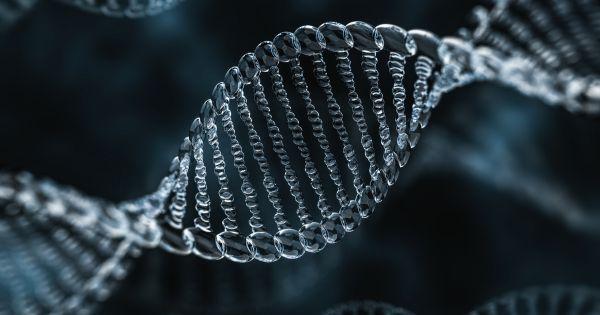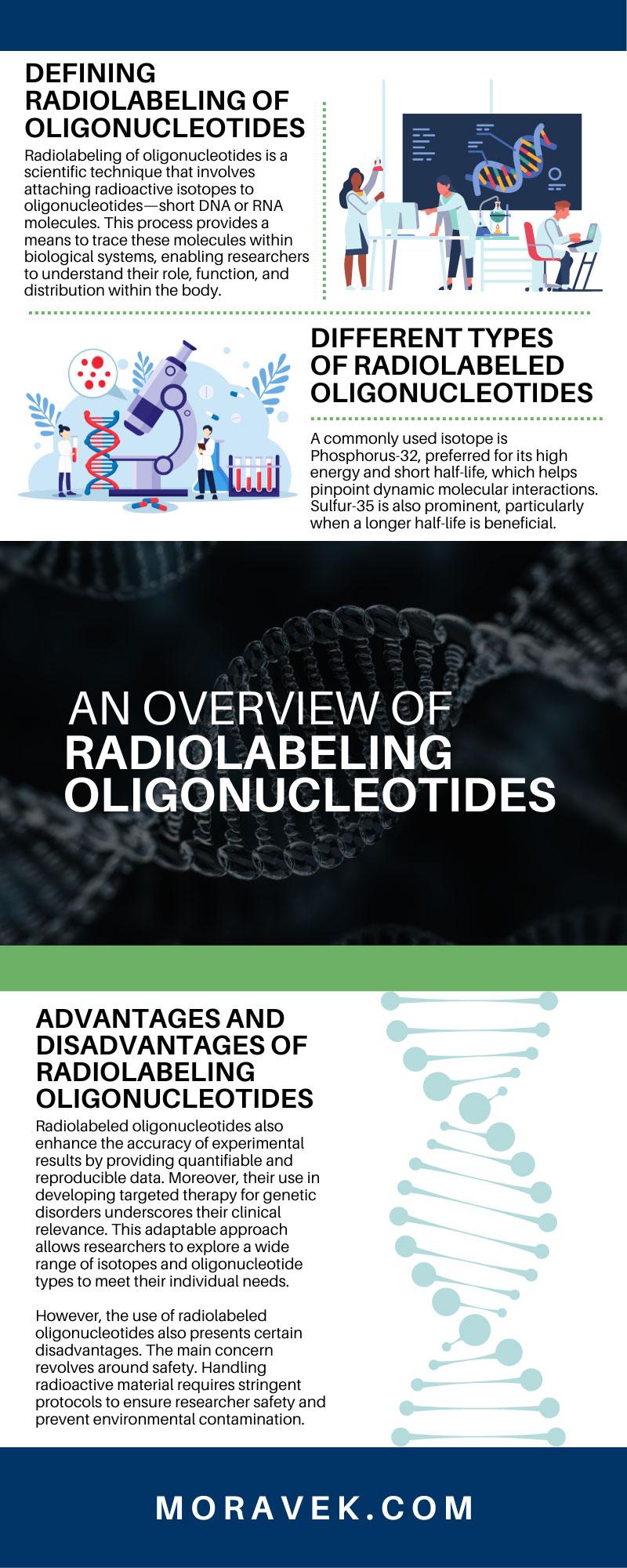
Radiolabeling of oligonucleotides, a sophisticated technique seamlessly merging nuclear technology with biomedical research, forms the crux of many groundbreaking scientific investigations.
The importance of this technique rests in its power to unlock the mysteries of genetic behavior and disease processes, pushing the boundaries of our understanding and revolutionizing the landscape of medical research. As we delve deeper into this overview of radiolabeling oligonucleotides, we can find a better understanding and appreciation of what it entails.
Defining Radiolabeling of Oligonucleotides
Radiolabeling of oligonucleotides is a scientific technique that involves attaching radioactive isotopes to oligonucleotides—short DNA or RNA molecules. This process provides a means to trace these molecules within biological systems, enabling researchers to understand their role, function, and distribution within the body.
This method’s significance in a biological study is immense, as it allows for real-time tracking, facilitating in-depth studies of gene expression, protein binding, and the fundamental mechanisms of life at a molecular level.
Radiolabeled oligonucleotides are instrumental in the development of innovative therapies for genetic disorders. This technique has also proven critical to personalized medicine, offering insights into how individual genetic makeup can impact their treatment responses.
Radiolabeling of oligonucleotides has become increasingly important in biomedical research because of how accurate it is when quantifying oligonucleotides and its capacity to track and localize them inside cells and tissues.
Different Types of Radiolabeled Oligonucleotides
The radiolabeled oligonucleotides landscape is diverse, characterized by the various types of radioactive isotopes utilized and the specific oligonucleotides chosen.
A commonly used isotope is Phosphorus-32, preferred for its high energy and short half-life, which helps pinpoint dynamic molecular interactions. Sulfur-35 is also prominent, particularly when a longer half-life is beneficial.
On the other hand, oligonucleotide selection often hinges on the specific research objectives. For instance, biomedical research frequently employs antisense oligonucleotide, primer, probe, and aptamer radiolabeled molecules.
Each type serves a unique function, such as inhibiting gene expression, amplifying DNA, detecting specific sequences, or target molecule binding. Thus, the radioactive isotope and oligonucleotide diversity broaden the utility and flexibility of radiolabeling in biomedical research.
Advantages and Disadvantages of Radiolabeling Oligonucleotides
Radiolabeled oligonucleotides offer significant advantages in biomedical research. They permit high-resolution imaging of cellular processes, enabling real-time tracking of molecular activities—contributing to a deeper understanding of gene function, protein interactions, and cellular mechanisms.
Radiolabeled oligonucleotides also enhance the accuracy of experimental results by providing quantifiable and reproducible data. Moreover, their use in developing targeted therapy for genetic disorders underscores their clinical relevance. This adaptable approach allows researchers to explore a wide range of isotopes and oligonucleotide types to meet their individual needs.
However, the use of radiolabeled oligonucleotides also presents certain disadvantages. The main concern revolves around safety. Handling radioactive material requires stringent protocols to ensure researcher safety and prevent environmental contamination.
Additionally, using radiolabeled oligonucleotides in humans raises ethical concerns due to potential damage from radiation exposure. Lastly, the short half-life of commonly used isotopes necessitates frequent synthesis of fresh batches, which can be time-consuming and cost-prohibitive.
Steps Involved in the Process of Radiolabeling Oligonucleotides
Radiolabeling of oligonucleotides is a fascinating process that follows a series of carefully orchestrated steps. It begins with selecting an oligonucleotide, a short snippet of DNA or RNA, and a radioactive isotope, like Phosphorus-32 or Sulfur-35.
Scientists use this isotope to “tag” our tiny molecules. The attachment process, known as the “labeling reaction,” relies on a special enzyme, Polynucleotide Kinase, which acts as a molecular glue, fusing the isotope and the oligonucleotide.
Once the reaction is complete, individuals must ensure the new radioactive oligonucleotide is pure and ready for use by washing away unwanted components.
Then, through autoradiography, we can use this radiolabeled oligonucleotide to see what was previously invisible, track its journey in real time, and uncover its interactions and roles within a cell, like a molecular GPS. It’s a complex process indeed, but one that holds profound implications for our understanding of the biological world.
Tips for Successfully Radiolabeling Oligonucleotides
Meticulous planning and execution are paramount to ensure successful oligonucleotide labeling. Start by selecting an appropriate oligonucleotide and isotope. The oligonucleotide should be specific to the intended application, while the isotope’s half-life should coincide with the experiment’s duration. Second, employing a high-quality Polynucleotide Kinase and adjusting parameters like temperature, pH, and incubation time might improve the efficiency of your labeling procedure.
Post-labeling, a rigorous cleanup process, is crucial to eliminate unincorporated isotopes, which could cause erroneous results. Scientists typically employ techniques like gel filtration or spin columns for this cleanup. Furthermore, scientists must verify the purity and integrity of the radiolabeled oligonucleotide through gel electrophoresis and autoradiography.
Lastly, scientists must always adhere to strict safety measures when handling radioactive material, including protective equipment, proper waste disposal, and regular contamination checks. Following these guidelines can enhance the reliability and reproducibility of radiolabeling experiments, paving the way for successful biomedical research.
Potential Applications of Radiolabeling Oligonucleotides R&D
The potential applications of radiolabeled oligonucleotides in research and development are manifold and impactful. Their primary use is in nucleic acid research, which allows scientists to elucidate the molecular processes that govern the course of life. Scientists can observe gene expression and function nuances, revealing how genes interact with other cellular components, by tracking these radiolabeled molecules. This invaluable information could uncover novel targets for drug development.
Furthermore, radiolabeled oligonucleotides are crucial in developing targeted therapeutics, particularly for genetic diseases. Researchers can inhibit or alter gene expression by designing oligonucleotides that bind to specific genetic sequences, paving the way for personalized medicine.
In diagnostic research, these radiolabeled molecules can detect specific DNA or RNA sequences, aiding in early disease detection. However, while the prospects are exciting, it’s important to underscore that each application has its challenges and complexities. Rigorous testing, validation, and safety considerations are imperative for progress in this promising field.
This overview of radiolabeling oligonucleotides details how it continues to revolutionize biomedical research by offering unprecedented insights into the intricacies of life at the molecular level. Though complex, this technique provides a tool for real-time gene tracking, enabling a deeper understanding of gene function, cellular mechanisms, and disease progression.
Beyond research, the clinical potential of radiolabeled oligonucleotides is thrilling as it opens avenues for targeted therapies and personalized medicine. However, the handling of radioactive material necessitates scrupulous safety measures.
Researchers across the globe may make use of Moravek’s radiolabeling services, which use carbon-14 and tritium. We provide a large catalog of radiolabeled compounds and bespoke radiolabeling services to meet the demands of a broad range of research projects.

